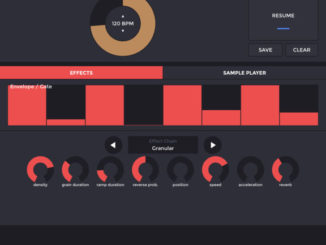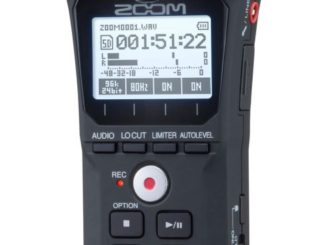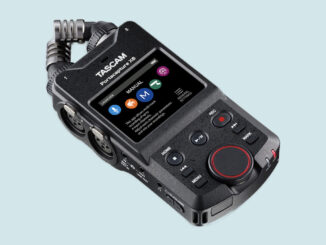NAMM 2024: Zoom has introduced the Essential series, three (H1, H4, and H6) new field recorders with 32-bit float, bigger display, and more.
As some people know, I am a long-time Zoom customer. I have been using the H6 field recorder for recordings at trade fairs, in the studio and also for field recording for almost ten years. One of my favorite devices.
In the last few months, Zoom has upgraded more and more products in its portfolio to 32-bit technology. The H series was left out so far. Until NAMM 2024!
Zoom Essential Series
In time for NAMM 2024, Zoom upgraded its popular H series field recorders. Honestly, Zoom: I’m a little irritated by the design. The classic look that the H series had is gone.
In my opinion, they failed a bit to achieve a modern look. The blue buttons, in particular, make the new H Essential series look cheaper than the OGs. I already miss the classic H6 design. However, I would like the new great features in my old, rocked H6.
All three models (H1, H4, H6) have some things in common. Starting from the highlight: 32-bit technology. With 32-bit float recording, you never have to adjust levels.
They also now host a USB-C port instead of the mini USB, allowing you to connect it as a USB mic or USB audio interface to your PC, Mac, iOS, or Android device. Plus, they share the SD card for up to 1TB (SDXC) of recordings and are battery-operated.
Another new addition are the newly developed blue soft touch buttons for quiet operation. Also, Zoom has designed the Essential Series with accessibility for the build and visually impaired. Navigate the menu with audible descriptions (English, German, French, Spanish…) through the built-in speaker or headphones.
Built-in speakers for instant playback of your recordings, 3.5mm mic/input, and outputs offering more connectivity are also onboard. But there are differences.
Zoom H1 Essential
Like the original H1, the new H1 Essential remains a 2-in/2-out field recorder with an onboard X/Y microphone, capturing clean audio up to 120 dB SPL. Then, it comes again with the handy 3.5mm mic/line input for lavalier microphones and the 3,5mm output for routing out the signal to cameras.
A new dedicated marker button allows you to set reference points instantly while recording.
Zoom H4 Essential
The H4 Essential features the two XLR/TRS combo inputs based on Zoom’s ultra-clean preamps that support phantom power and +4dBu professional line level input. I
The onboard X/Y microphones can capture sound up to a thunderous 130 dB SPL, equivalent to a rock concert. So you get four tracks in total on which you can record. H4 Essential is fully compatible with the BTA-1 Bluetooth adapter (separate purchase), allowing you to pair it with iOS devices. It’s a shame that Bluetooth isn’t included in the hardware.
A new vivid full-color LCD screen makes it easy to navigate through the H4essential’s menu and functions.
Zoom H6 Essential
Last but not least is the flagship from the H6 Essential series. It features four XLR/TRS combo inputs (ultra-clean Zoom preamps) and a new X/Y microphone based on the next-generation 3.0 capsule system with 32-bit float support. It gives you a total of six tracks.
Additionally, you can purchase the new EXH-6e capsule, giving you two additional XLR inputs, perfect for podcasters. The new H6 Essential also has a new display that features a waveform display and gives you full control over the built-in mixer. It’s also fully compatible with the BTA-1 Bluetooth adapter.
A new option is also to detach the capsule and use the included cap for a low-profile setup.
First Impression
The new H6 is finally here. A nice, solid update in terms of features. The only thing that doesn’t really appeal to me is the design of the Essential series.
The new Zoom Essential series will be available in Q2 2024. The H1 Essential for 129,71€, H4 Essential for 260,61€, and the H6 Essential for 391,51€
More information here: Zoom







Returning my new zoom r4…just under the return window.. so glad i saw this! I’m happy to wait a couple of months for the massive upgrade over the r4. Zoom should have NEVER released it with these in the pipeline.
Well, these a different devices. There’s no bounce feature or effects on the H-series. I’m VERY glad they released the R4, it’s a great little recorder. And I do put reverb on every track I record with it!
One of the things I really like about the H2n is that it has a default Mid-Side mics/mode for recording stereo. This is just a little bit nicer than having the coincident pair that is featured on this series. I suppose it is possible that the quality of the mics and/or preamps could swing it in favor of the latter, but purely for versatility and quality of stereo– M/S is hard to beat, IMHO.
I wish Zoom had kind of stuck with the M/S thing for their products. Unfortunately, consumers need to be convinced in less than one sentence, and M/S takes some words.
Yeah, I agree the new design is weird. Even for feel I think i’d prefer the buttons and designs of the current H6 etc. More tactile with the dials etc. I probably should pick one up before they’re gone I suppose 😛
Hello
Why does Zoom name them “Essential series” ? Does Zoom plan to release an “Advanced serie” ?
Regards
don’t know sorry
Well, I’m sticking to my used H5 that I bought last year with X/Y capsule and carry case for the price of new H1 Essential. Which now seems like an insane deal, considering I bought it on eBay.
But this will be probably good for 2nd hand market, as older models will now be cheaper (with people GASing over the new ones).
Meanwhile, the existing Zoom H1n is available for 59,84€ at Thomann…?! (an insane deal admittedly). So, what really makes the new “Essential” for 129,71€ as per the article worth the steep extra? A new dedicated marker button and some blue plastic magic? 😉
32-bit recordings, means you don’t must check your levels
That was already true at 24-bit though… hence the above.
na, if you doesn’t attention to your signals, you have easily clipping and cracked audio in the H6. Often experienced, I use it since nearly 10 years
The reason the jump to 24-bit recordings is so important is not because 16-bit is that bad at peak levels in itself; instead it has to do with the effectively available headroom and resolution when recording. Let me give you an intentionally very simple example:
* 16-bit values allow for up to 2^16 = 65536 different values per sample. When you seek to have sufficient digital audio recording headroom to allow for dynamic range peaks etc, let’s say e.g. ~25% to keep things super-simple, you will take a chunk out of that resolution, effectively meaning maybe 12000000 (12 million!) values to describe your signal, and implicitly then also including a much much higher resolution to describe the weaker parts thereof, and a lower digital noise floor.
* 32-bit values, just to put things fully into perspective, allow for up to 2^32 = 4294967296 (i.e. more than 4 billion!) different values per sample. This – and sometimes even more actually – can be very useful in certain cases like e.g. in the multi-track summing and mastering stages, cf. e.g. when mixing down many individual 24-bit channels to a master sum, which is subsequently smartly converted down from its super-high-res form to e.g. 24-bit for the output file(s), cf. popular high-res audio formats like 24-bit 96/192 kHz and similar.
Bottom line, if you’re experiencing clipping and crackling in your recordings, the problem is unlikely to be in the 24-bit digital domain; rather then in the analog domain like microphone pre-amp stages etc. In other words, for (relatively speaking) simple few-channel, non-mastering use cases like the field recorders we’re talking about here, I would argue that dropping the “it’s now 32-bit!!!” value argument is just plain old marketing fluff. Which, to bring us back to my prior post, also puts a big real world questionmark on any price hikes associated with this new generation of products.
(Implicit from the above, then, is also that with the transition from 16-bit to 24-bit recording you should now effectively be able to lower your input volume even further than you used to be practically able to, to further reduce the risk of clipping etc, while still retaining very good audio resolution at all signal levels.)
For clarity, be aware that my comment above was badly messed up by the posting system; I have the original text saved and a big chunk in the middle was lost for reasons unknown:
(…)
* 16-bit values allow for up to 2^16 = 65536 different values per sample. When you seek to have sufficient digital audio recording headroom to allow for dynamic range peaks etc, let’s say e.g. ~25% to keep things super-simple, you will take a chunk out of that resolution, effectively meaning maybe 12000000 (12 million!) values to describe your signal, and implicitly then also including a much much higher resolution to describe the weaker parts thereof, and a lower digital noise floor.
(…)
…and it did it again, sigh. Dropped a key chunk of the post in between 16-bit and 24-bit. Tom, you may want to look into this bug at some point…
I don’t see any irregularities in your comments. What is wrong?
OK, let’s try pasting just the missing part once more and see what happens then… 😐
“…let’s say e.g. ~25% to keep things super-simple, you will take a chunk out of that resolution, effectively meaning maybe 12000000 (12 million!) values to describe your signal, and implicitly then also including a much much higher resolution to describe the weaker parts thereof, and a lower digital noise floor.”
Nope, it did it again. Can I email you the original text instead perhaps Tom?
I was at NAMM with a friend of mine who is the drummer for a famous heavy metal band, and records drums all the time. Unprompted, he started to praise the new 32-bit recorders. He’s a Zoom artist so he has had the new recorder prior to launch. He said he could not make it clip. He hit a snare right in front of the mic, pulled the file out of it. When you first look at the waveform, you might think it is clipped, but then when you zoom in, you see there is still headroom. I can’t wait to try one out.
Is it possible they might implement a bounce feature like the r4? I’ve seen that the H6 technically has eight channels, but it accepts 6 audio inputs.
Ah, I think I maybe have found the issue with your comments system – looking at the likely clipping points (heh) it seems it maybe doesn’t like the used-by-HTML smaller than / larger than characters, i.e. does not translate them into character codes as it should. Let me try one last time then… 🙂
“The reason the jump to 24-bit recordings is so important is not because 16-bit is that bad at peak levels in itself; instead it has to do with the effectively available headroom and resolution when recording. Let me give you an intentionally very simple example:
* 16-bit values allow for up to 2^16 = 65536 different values per sample. When you seek to have sufficient digital audio recording headroom to allow for dynamic range peaks etc, let’s say e.g. ~25% to keep things super-simple, you will take a chunk out of that resolution, effectively meaning maybe less than 50000 values left to describe your signal, while weaker parts thereof move even closer to the digital noise floor.
* 24-bit values, on the other hand, allow for up to 2^24 = 16777216 (i.e. more than 16 million!) different values per sample. Using the same simplified assumption with regards to desired recording headroom (~25%) as above, this would still leave you with more than 12000000 (12 million!) values to describe your signal, and implicitly then also including a much much higher resolution to describe the weaker parts thereof, and a lower digital noise floor.
* 32-bit values, just to put things fully into perspective, allow for up to 2^32 = 4294967296 (i.e. more than 4 billion!) different values per sample. This – and sometimes even more actually – can be very useful in certain cases like e.g. in the multi-track summing and mastering stages, cf. e.g. when mixing down many individual 24-bit channels to a master sum, which is subsequently smartly converted down from its super-high-res form to e.g. 24-bit for the output file(s), cf. popular high-res audio formats like 24-bit 96/192 kHz and similar.
Bottom line, if you’re experiencing clipping and crackling in your recordings, the problem is unlikely to be in the 24-bit digital domain; rather then in the analog domain like microphone pre-amp stages etc. In other words, for (relatively speaking) simple few-channel, non-mastering use cases like the field recorders we’re talking about here, I would argue that dropping the “it’s now 32-bit!!!” value argument is just plain old marketing fluff. Which, to bring us back to my prior post, also puts a big real world questionmark on any price hikes associated with this new generation of products.
(Implicit from the above, then, is also that with the transition from 16-bit to 24-bit recording you should now effectively be able to lower your input volume even further than you used to be practically able to, to further reduce the risk of clipping etc, while still retaining very good audio resolution at all signal levels.)”
That did it!!! 😀
Tom, now you know the issue with your comments system; see above.
good to see that you have manage it 🙂 however, can’t change the system of it 🙂
only 92kHz recording? WTF!!! forget use ultrasonic mics !!! I would expect 384kHz
Please, Zoom why, why?